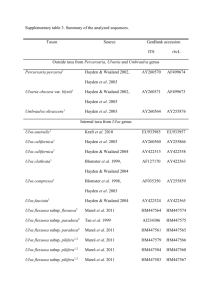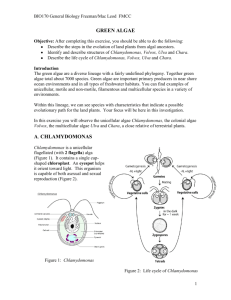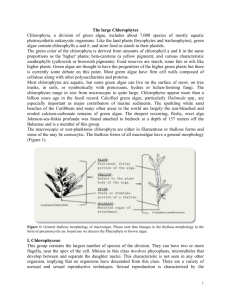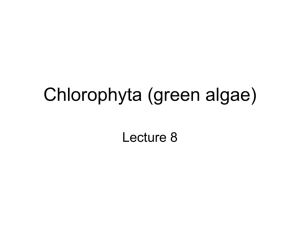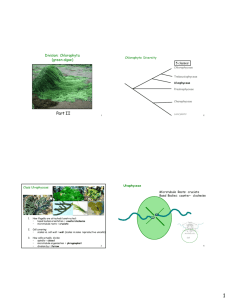Enteromorpha-like Ulva (Ulvophyceae, Chlorophyta) Growing in the
advertisement
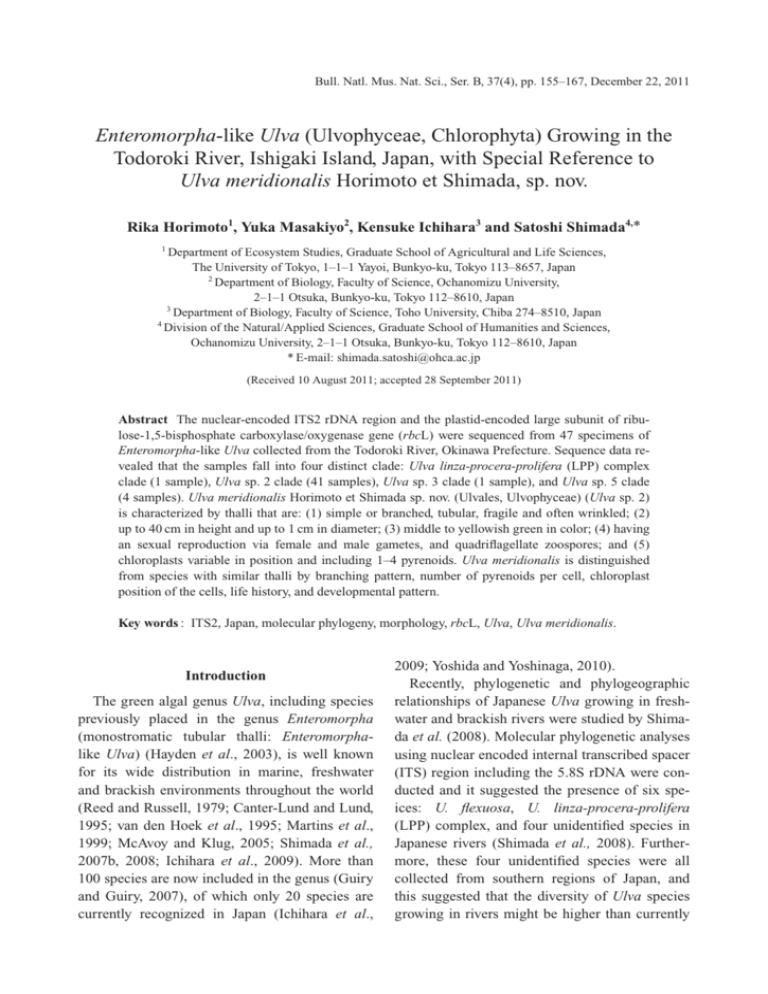
Bull. Natl. Mus. Nat. Sci., Ser. B, 37(4), pp. 155–167, December 22, 2011 Enteromorpha-like Ulva (Ulvophyceae, Chlorophyta) Growing in the Todoroki River, Ishigaki Island, Japan, with Special Reference to Ulva meridionalis Horimoto et Shimada, sp. nov. Rika Horimoto1, Yuka Masakiyo2, Kensuke Ichihara3 and Satoshi Shimada4,* 1 Department of Ecosystem Studies, Graduate School of Agricultural and Life Sciences, The University of Tokyo, 1–1–1 Yayoi, Bunkyo-ku, Tokyo 113–8657, Japan 2 Department of Biology, Faculty of Science, Ochanomizu University, 2–1–1 Otsuka, Bunkyo-ku, Tokyo 112–8610, Japan 3 Department of Biology, Faculty of Science, Toho University, Chiba 274–8510, Japan 4 Division of the Natural/Applied Sciences, Graduate School of Humanities and Sciences, Ochanomizu University, 2–1–1 Otsuka, Bunkyo-ku, Tokyo 112–8610, Japan * E-mail: shimada.satoshi@ohca.ac.jp (Received 10 August 2011; accepted 28 September 2011) Abstract The nuclear-encoded ITS2 rDNA region and the plastid-encoded large subunit of ribulose-1,5-bisphosphate carboxylase/oxygenase gene (rbcL) were sequenced from 47 specimens of Enteromorpha-like Ulva collected from the Todoroki River, Okinawa Prefecture. Sequence data revealed that the samples fall into four distinct clade: Ulva linza-procera-prolifera (LPP) complex clade (1 sample), Ulva sp. 2 clade (41 samples), Ulva sp. 3 clade (1 sample), and Ulva sp. 5 clade (4 samples). Ulva meridionalis Horimoto et Shimada sp. nov. (Ulvales, Ulvophyceae) (Ulva sp. 2) is characterized by thalli that are: (1) simple or branched, tubular, fragile and often wrinkled; (2) up to 40 cm in height and up to 1 cm in diameter; (3) middle to yellowish green in color; (4) having an sexual reproduction via female and male gametes, and quadriflagellate zoospores; and (5) chloroplasts variable in position and including 1–4 pyrenoids. Ulva meridionalis is distinguished from species with similar thalli by branching pattern, number of pyrenoids per cell, chloroplast position of the cells, life history, and developmental pattern. Key words : ITS2, Japan, molecular phylogeny, morphology, rbcL, Ulva, Ulva meridionalis. Introduction The green algal genus Ulva, including species previously placed in the genus Enteromorpha (monostromatic tubular thalli: Enteromorphalike Ulva) (Hayden et al., 2003), is well known for its wide distribution in marine, freshwater and brackish environments throughout the world (Reed and Russell, 1979; Canter-Lund and Lund, 1995; van den Hoek et al., 1995; Martins et al., 1999; McAvoy and Klug, 2005; Shimada et al., 2007b, 2008; Ichihara et al., 2009). More than 100 species are now included in the genus (Guiry and Guiry, 2007), of which only 20 species are currently recognized in Japan (Ichihara et al., 2009; Yoshida and Yoshinaga, 2010). Recently, phylogenetic and phylogeographic relationships of Japanese Ulva growing in freshwater and brackish rivers were studied by Shimada et al. (2008). Molecular phylogenetic analyses using nuclear encoded internal transcribed spacer (ITS) region including the 5.8S rDNA were conducted and it suggested the presence of six speices: U. flexuosa, U. linza-procera-prolifera (LPP) complex, and four unidentified species in Japanese rivers (Shimada et al., 2008). Furthermore, these four unidentified species were all collected from southern regions of Japan, and this suggested that the diversity of Ulva species growing in rivers might be higher than currently 156 Rika Horimoto et al. Table 1. Specimens of Enteromorpha-like Ulva used in this study Accession no. Sample Locality, collection date ITS2 LPP complex RH008 U. meridionalis RH001–007, RH009–037, RH043–047 E16 Ulva sp. 3 RH038 Ulva sp. 5 RH039–042 rbcL Todoroki River, Ishigaki Island, Okinawa Prefecture, 2009/2/16 AB598806 AB598810 Todoroki River, Ishigaki Island, Okinawa Prefecture, 2009/2/16 AB598807 AB598812 Yoshino River, Tokushima, Tokushima Prefecture, 2000/7/18 AB298457 AB598813 Todoroki River, Ishigaki Island, Okinawa Prefecture, 2009/2/16 AB598809 AB598814 Todoroki River, Ishigaki Island, Okinawa Prefecture, 2009/2/16 AB598808 AB598811 appreciated in Japanese warm regions (Shimada et al., 2008). In this study, we conducted a field survey in estuary of the Todoroki River, Ishigaki Island, the Ryukyu archipelago of southwest Japan, where “Ulva sp. 2” was found in Shimada et al. (2008). We carried out phylogenetic analyses of the nuclear-encoded internal transcribed spacer 2 (ITS2) region, and the large subunit of the plastid-encoded rbcL gene. In addition, to clarify the status of the alga that was treated as “Ulva sp. 2” in Shimada et al. (2008), we studied the morphology of field and cultured materials and determined its life history. Materials and Methods Materials used in this study were collected from the Todoroki River (24°22N, 124º15E), Ishigaki Island, Okinawa Prefecture, Japan. Collection details are shown in Table 1. The specimens were transported live to Ochanomizu University for culture studies. Unigal cultures were established from zoids. Total DNA was extracted from field or culture materials (Table 1) using the Dneasy Plant Mini Kit (QIAGEN, Valencia, CA, USA) following the protocol of the manufacturer. In this study, we used three pairs of primers: ITS3-ITS4 for ITS2 (Malta et al., 1999); rbcLstart-R750 and F650-rbcLend for rbcL (Shimada et al., 2003). Polymerase chain reaction (PCR) amplifications of the ITS2 region and rbcL gene were run on a thermocycler (Veriti® 96-Well Thermal Cycler, Applied Biosystems, CA, USA). The profile of the reactions for ITS2 region consisted of one initial denaturation of 1 min at 94°C followed by 35 cycles of denaturation of 15 sec at 95°C, primers annealing of 15 sec at 50°C and extension of 30 sec at 68°C, terminated by a final hold at 4°C; and that for rbcL gene consisted of one initial denaturation of 1 min at 94°C followed by 45 cycle of denaturation of 15 sec at 95°C, primers annealing of 30 sec at 50°C and extension of 60 sec at 68°C, terminated by a final hold at 4°C. The presence of the PCR-amplified products was visualized under UV light after agarose gel electrophoresis and staining with ethidum bromide. PCR-amplified products were cleaned using the QIAquick PCR Purification Kit (QIAGEN). We sequenced the ITS2 region and rbcL gene from 47 samples (Table 1). Additional rbcL sequences were generated from 3 samples previously analyzed ITS sequences in Shimada et al. (2008). Moreover, 45 ITS2 sequences and 52 rbcL sequences were downloaded from GenBank and included in the alignments. The ITS2 sequences (295 bp) were aligned by eye with regard to their secondary structure using the mFOLD program (Zuker, 1989). The rbcL sequences (1308 bp) were aligned manually because no deletion/insertion was detected. The alignments are available from the last author upon request. Three species of Ulvales, Umbraulva olivascens (Dangeard) Bae et Lee, Umbraulva amamiensis (Tanaka) Bae et Lee, and Umbraulva japonica (Holmes) Bae et Lee were included in ITS2 aligment; four species of Ulvales, Ulvaria fusca (Wittrock) Vinogradova, Ulvaria obscura var. Enteromorpha-like Ulva (Ulvophyceae, Chlorophyta) blyttii (J.E. Areschoug) Bliding, Umbraulva amamiensis, and Umbraulva japonica were included in rbcL aligment as out groups in each dataset to understand the relationships of our alga among the genus Ulva (Ichihara et al., 2009). The maximum likelihood (ML) method was used to construct phylogenetic trees with PAUP* 4.0 b10 (Swofford, 2002). Regions of uncertain homology in the ITS2 alignment (105–119, 144–163) and identical sequences were excluded from alignment. The program MODELTEST version 3.7 (Posada and Crandall, 1998) was used to find the model of rbcL sequence evolution that best fit each dataset by a hierarchical likelihood ratio test (a 0.01). Takahashi and Nei (2000) suggested that a simple model is better when a large number of short sequences are analyzed. Thus, we used the JC model (Jukes and Cantor, 1969) in the ITS2 analysis. When the best sequence evolution model was determined, ML tree searches were carried out using estimated model parameters with following options: starting tree obtained by stepwise addition, and tree bisection and reconnection (TBR) branch swapping algorithm. Bootstrap values (Felsenstein, 1985) based on 100 resamplings in ML and 2000 re-samplings in MP calculated (TBR, full heuristic search option). We formed the secondary structure of ITS2 of “Ulva sp. 2” (RH001, NY138, NY140, E16, C591, C593), U. flexuosa Wulfen subsp. paradoxa (C. Agardh) Kraft, and Ulva sp. 3 (RH038, TT002) and compared the contiguous 5-side 30 nucleotide positions of helix III. Secondary structure of ITS2 was derived by applying the ITS2 data base (http://its2.bioapps.biozentrum. uni-wuerzburg.de/). Field and cultured samples of “Ulva sp. 2” including sample E16 (SAP 102989) collected at Yoshino River, Tokushima, Tokushima Prefecture (Shimada et al., 2008) were used for morphological observations. The morphological characters used in this study were as follows: thallus form, texture and color, shape, size, number of pyrenoids, and chloroplast position of the cells. Voucher herbarium specimens are deposited in 157 the Herbarium of Graduate School of Science, Hokkaido University, Sapporo (SAP 10847108355) and the Herbarium of the National Museum of Nature and Science (TNS-AL 173588), located at Tsukuba City, Japan. For observations on the algal life history of “Ulva sp. 2”, we used the punching methods described by Hiraoka and Enomoto (1998) and obtained zoides. Released zoides were cultured at 22.5°C, with a 12:12 h light : dark (LD) cycle under fluorescent light at 100 m mol m2 s1 in 30 psu artificial seawater (Sea Life, Marine Tech Co., Tokyo, Japan) supplemented with PES medium (Provasoli, 1968). Cultured thalli were artificially induced to release zoids again using the punching method, and released zoids were cultured under the same conditions as mentioned above. Results Molecular phylogenetic analyses Maximum likelihood analysis of ITS2 sequences with the JC model produced a topology shown in Fig. 1 (ln L2174.26303). The 47 samples from the Todoroki River were resolved into four clades, of which 41 samples were included in “Ulva sp. 2” clade with high bootstrap values (87 ML/96MP). The ITS2 sequences of all 41 samples were identical and there were only 0– 4 substitutions (0–1.587%) in the “Ulva sp. 2” clade. “Ulva sp. 2” was clustered with U. flexuosa subsp. paradoxa, but the bootstrap support was less than 50% in ML analyses and 53% in MP analyses. One sample (RH008, SAP 108356) was included in Ulva linza-procera-prolifera (LPP) complex clade, but the bootstrap support was less than 50% in ML analyses and 67% in MP analyses. The other one sample (RH038, SAP 108357) was included in Ulva sp. 3 clade with 100% bootstrap support in both analyses. The remaining one clade did not include GenBank samples with which they could be identified and were thus provisionally referred to as Ulva sp. 5 (RH039–RH042, SAP 108358). The ITS2 sequences of these four samples of Ulva sp. 158 Rika Horimoto et al. 5 were identical, and Ulva sp. 5 was sister to U. clathratioides with high bootstrap support (90 ML/97MP). Likelihood settings of the rbcL gene from the best-fit model (GTRGI) were selected (assumed nucleotide frequencies A0.28160, C 0.15490, G0.21690, and T0.34660). ML analysis produced the topology shown in Fig. 2 (ln L4798.80231). As in the case of ITS2 analysis, the 13 samples from the Todoroki River were resolved into four clades: “Ulva sp. 2” clade (nine samples), LPP complex clade (one sample), Ulva sp. 3 clade (one sample), and Ulva sp. 5 clade (two samples). “Ulva sp. 2” clade received high bootstrap support (89 ML/94MP) and there were only 0–1 substitutions (0–0.076%) in this clade. “Ulva sp. 2” was sister to Hawaii Ulva sp. OTU11 with high bootstrap support (98 ML/100MP). LPP complex clade was clustered with U. prolifera with moderate bootstrap support (60 ML/62MP). Ulva sp. 3 was sister to Hawaii Ulva sp. OTU6 with high bootstrap support (98 ML/98MP). Ulva sp. 5 was sister to NZ Ulva sp. 2, U. clathratioides, and Hawaii Ulva sp. OTU5 with high bootstrap support (97 ML/99MP). Comparison of ITS2 5-side 30 nucleotide position of helix III There existed 0–2 hemi-CBC (Compensatory Base Change) within “Ulva sp. 2”, 6-8 hemiCBC between “Ulva sp. 2” and U. flexuosa subsp. paradoxa, and 2–4 hemi-CBC between “Ulva sp. 2” and Ulva sp. 3. CBC was not existed in all these cases. Morphological observations Field material of “Ulva sp. 2” Well-developed thalli (Figs. 3, 4) grow up to 40 cm in height, and up to 1 cm in diameter, are medium to yellowish green in color, fragile and break easily. The thalli are tubular, wrinkled especially in wider parts, and simple or branched up to second order. In the upper basal region, cells are 9.5–22.9 m m in length (average 14.8 m m, standard deviation (SD)2.3) and 6.1–15.9 m m in width (10.5 m m1.7); in the middle region, those are 8.7–20.2 m m in length (14.5 m m 1.9) and 5.4–15.6 m m in width (10.5 m m1.6); and in the upper region, those are 8.4–20.2 m m in length (14.0 m m2.0) and 4.8–16.6 m m in width (10.1 m m1.9). Three types of chloroplast positions were observed in the upper basal region (lie against a side wall, giving a lattice appearance, 30% of samples; covers the outer face of cell, 30% of samples; and both types of chloroplast positions are mixed, 40% of samples), in the middle region (lie against a side wall, giving a lattice appearance, 19% of samples; covers the outer face of cell, 35% of samples; and both types of chloroplast positions are mixed, 46% of samples), and in the upper region (lie against a side wall, giving a lattice appearance, 27% of samples; covers the outer face of cell, 49% of samples; and both types of chloroplast positions are mixed, 24% of samples) (Figs. 5–7). Each cell includes 1–4 pyrenoids in the upper basal region (one, 49.3%; two, 47.2%; three, 3.4%; and four, 0.1% of cells examined), in the middle region (one, 48.58%; two, 48.19%; three, 3.19%; and four, 0.03%), and in the upper region (one, 50.46%; two, 46.38%; three, 3.16%; and four, 0.03%) (Figs. 5–7). Cells in surface view are polygonal or square (Figs. 5–7). Cultured thalli of “Ulva sp. 2” Both samples from Ishigaki island and Tokushima Prefecture are tubular, yellowish green, with up to second order branches, and have rhizoidal cells bearing tubular extensions on the inside of the cell layer in the stipe in the longitudinal sections (Fig. 8). In samples from Ishigaki Island, in the upper basal region, cells are 15.7–23.0 m m in length (19.2 m m1.6) and 9.4–16.3 m m in width (12.7 m m1.4); in the middle region, those are 12.3–22.3 m m in length (17.5 m m2.1) and 7.7–17.4 m m in width (12.0 m m1.7); and in the upper region those are 14.0–22.8 m m in length (18.3 m m1.7) and 8.5– 16.7 m m in width (11.9 m m1.6). Two or 3 types of chloroplast positions were observed in the upper basal region (covers the outer face of cell, Enteromorpha-like Ulva (Ulvophyceae, Chlorophyta) 159 Fig. 1. Phylogenetic tree of maximum likelihood (ML) analysis inferred from the nuclear-encoded ITS2. Numerals at internal nodes are bootstrap values 50% for 100 replicates in ML and 2000 replicates in maximum parsimony (MP) analyses (ML/MP). * 100. 25% of samples and both types of chloroplast positions are mixed, 75% of samples), in the middle region (lie against a side wall, giving a lattice appearance, 11.1% of samples; covers the outer face of cell, 44.4% of samples; and both types of chloroplast positions are mixed, 44.4% of samples), and in the upper region (covers the outer face of cell, 44.4% of samples and both types of chloroplast positions are mixed, 55.6% of samples) (Figs. 9, 10). Each cell includes 1–4 pyrenoids in the upper basal region (one, 33.5%; two, 56.6%; three, 9.5%; and four, 0.3%), in the middle region (one, 33.6%; two, 54.8%; three, 10.4%; and four, 1.2%), and in the upper region (one, 30.2%; two, 56.4%; three, 11%. 2; and four, 2.1%) (Figs. 9, 10). Cells in surface view are polygonal or square (Figs. 9, 10). In sample E16 from Tokushima Prefecture, in the upper basal region, cells are 17.9–23.7 m m in length (20.8 m m1.5) and 9.7–16.1 m m in width (13.5 m m1.6); in the middle region, those are 15.3–22.0 m m in length (18.0 m m1.5) and 7.8– 160 Rika Horimoto et al. Fig. 2. Phylogenetic tree of maximum likelihood (ML) analysis inferred from plastid-encoded rbcL gene. Numerals at internal nodes are bootstrap values 50% for 100 replicates in ML and 2000 replicates in maximum parsimony (MP) analyses (ML/MP). * 100. 14.1 m m in width (10.5 m m1.6); and in the upper region those are 14.1–18.9 m m in length (16.2 m m1.2) and 8.3–14.0 m m in width (11.0 m m1.4). Chloroplast covers the outer face of cell. Each cell includes 1–4 pyrenoids in the upper basal region (one, 24.5%; two, 54%; three, 19.5%; and four, 2.0%), in the middle region (one, 19.5%; two, 68.5%; three, 11.0%; and four, 1.0%), and in the upper region (one, 19.0%; two, 70.5%; three, 10.0%; and four, 0.6%). Cells in surface view are polygonal or square. Life history of “Ulva sp. 2” Examined thalli (n22) released biflagellate female or male gametes (Figs. 11, 12) that displayed positive phototaxis. Female gametes are 6.60.54.20.4 m m, slightly larger than male ones that are 6.30.52.90.4 m m, so the species is slightly anisogamous. Female and male gametes copulated and formed zygotes that showed negative phototaxis. Zygotes attached to the substratum (Fig. 14), and the first cell division occurred within 2–4 days (Fig. 15). The germinated spores developed into uniseriate filaments (Fig. 16) and gave rise to tube-like thalli (Fig. 17). Neither early longitudinal divisions of cells nor branching was observed. Developed sporophytes released meiospores (Fig. 13) that Enteromorpha-like Ulva (Ulvophyceae, Chlorophyta) 161 Figs. 3 and 4. Samples collected at the Todoroki River, Ishigaki Island, Okinawa Prefecture (wet habit before pressing). 3. Holotype specimen of Ulva meridionalis (SAP 108347, RH010 in Table 1). 4. Isotype specimen of Ulva meridionalis (TNS-AL 17358, RH046 in Table 1). showed negative phototaxis and are 9.80.6 5.40.8 m m, which are larger than both female and male gametes. Based on these observations, this new species has a sexual reproduction via female and male gametes, and quadriflagellate zoospores. The developmental pattern of meiospores and parthenogenetic gametes was similar to that of zygotes as mentioned above. The phylogenetic and morphological differences between our alga and other species of Ulva provide a basis for the establishment of a new species, “Ulva sp. 2” as Ulva meridionalis Hori- moto et Shimada. Description Ulva meridionalis Horimoto et Shimada, sp. nov. Alga sulsuginea thallis tubulosis. rugosis, vel lubricis; thalli usque ad 40 cm in altitudine et 1 cm diametro, virides ad flavo-virentes, simplices vel ramos ordinis usque ad secondi gerentes. Cellulae rhizoideae extensiones tubulares gerentes intus stratum cellulas in basi thalli. Cellulae a 162 Rika Horimoto et al. Figs. 5–7. Anatomy of field materials of Ulva meridionalis. 5. Surface view of middle part of thallus (chloroplasts lie against a side wall, giving a lattice-like effect). 6. Surface view of middle part of thallus (chloroplasts cover the cells). 7. Surface view of middle part of thallus (chloroplasts lie against a side wall or cover the cells). Enteromorpha-like Ulva (Ulvophyceae, Chlorophyta) 163 Figs. 8–10. Anatomy of cultured materials of Ulva meridionalis. 8. Rhizoidal cells. 9. Surface view of middle part of thallus. 10. Surface view of upper part of thallus. 164 Figs. 11–13. Rika Horimoto et al. Reproductive cells of Ulva meridionalis. 11. Female gamete. 12. Male gamete. 13. Meiospore. Figs. 14–17. Development of Ulva meridionalis. 14. Settled zygote. 15. Four-day-old-germling. 16. Seven-dayold uniseriate germling. 17. 20-day-old filamentous sporophyte. facie visae speciminum nativorum irregulariter dispositae, polygonae vel quadratae, 8.4–20.2 4.8–16.6 m m inpartibus mediis et superis. Chloroplasti variabiles in positione et 1–4 pyrenoides includentes. Gametophyta dioecia, anisogametas biflagellatas producentia; gametae femineae 6.60.54.20.4 m m, gametae musculae 6.30.52.90.4 m m. Sporophyta meiosporas quadriflagellatas (9.80.65.40.8 m m) producentia. Brackish alga with tubular, winkled or lubricous thalli; the thalli up to 40 cm in height and 1 cm in diameter, green to yellowish green, simple or branched up to second order. Rhizoidal cells bearing tubular extensions on the inside of cell layer in the base of the thallus. Cells in surface view of field samples irregularly arranged, polygonal or square, 8.4–20.24.8–16.6 m m in the middle and upper regions. Chloroplasts variable in position and including 1–4 pyrenoids. Gametophytes dioecious, producing biflagellate anisogametes; female gametes 6.60.54.2 0.4 m m, male gametes 6.30.52.90.4 m m. Sporophytes producing quadriflagellate meiospores (9.80.65.40.8 m m). Holotype and type locality: SAP 108347 col- Enteromorpha-like Ulva (Ulvophyceae, Chlorophyta) lected at Ishigaki Island, Okinawa Prefecture, Japan by R. Horimoto (isotype, TNS-AL 17358). Etymology: The specific epithet means south in Latin. Japanese name: Minami-aonori Discussion We investigated the species diversity of Enteromorpha-like Ulva growing in the Todoroki River, using nuclear encoded ITS2 region and choloroplast encoded rbcL gene. Four groupings: LPP complex clade, U. meridionalis (Ulva sp. 2) clade, Ulva sp. 3 clade and Ulva sp. 5 clade were detected and which showed the diversity of Enteromorpha-like Ulva species in this river is higher than reported in Shimada et al. (2008). Ulva meridionalis can be distinguished morphologically from other Enteromorpha-like species of Ulva thalli as follows. In U. pseudolinza (R.P.T.Koeman et Hoek) Hayden et al., U. linza L., U. flexuosa subsp. linziformis (Bliding) Bliding and U. stipitata var. linzoides Bliding, the two layers are loosely adnate except for the hollow margin (Bliding, 1963; Koeman and van den Hoek, 1982a, b, 1984). Ulva simplex (K.L. Vinogradova) Hayden et al. mostly has spirally twisted stipe (Koeman and van den Hoek, 1982b). Ulva radiata (J.Agardh) Hayden et al. has many proliferations, thalli of U. torta (Mertens) Trevisan and U. ralfsii (Harvey) Le Jolis are filiform, and thalli of U. kylinii (Bliding) Hayden et al. are very long and narrow (Bliding, 1963; Koeman and van den Hoek, 1982b, 1984). Ulva compressa L., U. intsetinalis (L.) Link var. intestinalis Bliding, U. intsetinalis (L.) Link var. asexualis Bliding, U. intestinaloides (R.P.T.Koeman et Hoek) Hayden et al. and U. prolifera O.F.Müller have one perenoid per cell (90%); U. clathrata (Roth) C.Agardh, U. flexuosa subsp. biflagellate (Bliding) Bliding, U. multiramosa Bliding and U. aragoensis Bliding have more than one pyrenoids per cell; and U. flexuosa subsp. pilifera (Kützing) M.J.Wynne, U. flexuosa Wulfen, U. flexuosa subsp. paradoxa and U. hendayensis P.J.L.Dangeard et H.Parriaud have 1–5 165 or more pyrenoids per cell (Bliding, 1963; Koeman and van den Hoek, 1982a, 1984). Ulva jugoslavica Bliding has a sexual generation with small isogametes and an asexual generation with zoospores and U. adriatica Bliding has germings with early longitudinal divisions of cells (Bliding, 1963). Recently, Kraft et al. (2010) suggested the revisions to the Australian ulvaceous flora and four new species, U. clathratioides L.G.K.Kraft, Kraft et R.F.Waller, U. brisbanensis L.G.K.Kraft, Kraft et R.F.Waller, U. proliferoides L.G.K.Kraft, Kraft et R.F.Waller and U. stenophylloides L.G.K. Kraft, Kraft et R.F.Waller were proposed as the synthesis of both molecular and morphological data. Ulva meridionalis can be distinguished morphologically from these four species. Ulva clathratioides and U. proliferoides are densely and irregularly radically branched, thalli of U. brisbanensis are dark green in color, and U. stenophylloides is bilayered. Chloroplasts position of U. meridionalis was not fixed. Blomster et al. (1998) and Blomster (2000) classified the position of chloroplast into three types: type 1, central/pressed against cell walls/filled the cell in surface view (most species of Ulva); type 2, apical end of the cells/hoodshape/cap-shape (U. intestinalis and U. compressa); and type 3, mobile (only one species, U. clathrata). Therefore, U. meridionalis is the second report of type 3 chloroplast. Ulva clathrata is characterized by large cells and the presence of the large number of pyrenoids (Koeman and van den Hoek, 1984): in upper basal region, cells are (20–) 25 (–29)(14–) 16 (–19) m m; in the middle region, those are (19–) 22 (–25)(12–) 16 (–19) m m; in the apical region, those are (18–) 21 (–25)(12–) 15 (–18) m m. Each cell includes 3–7 pyrenoids in the upper basal region and 2–6 pyrenoids in the middle and apical regions. On the other hand, U. meridionalis lacks such features. These morphological differences between U. clathrata and U. meridionalis strongly support independent species of our new alga, Ulva meridionalis. Sequence analyses of the ITS2 and rbcL gene 166 Rika Horimoto et al. strongly support the independent status of U. meridionalis and its establishment as a new species. In the rbcL analyses, 7 bp–9 bp (0.610%– 0.696%) differences were found between U. meridionalis and most closely related entity, “OUT 11 Ulva sp.” from Hawaii (O’Kelly et al., 2010). This amount of sequence divergence in the rbcL gene is within the range of interspecific variation of previous studies of Ulva (Hayden and Waaland, 2002, 2004; Shimada et al., 2003), as well as other ulvophyceaen genera, such as Codium (Shimada et al., 2007a) and Caulerpa (Domis et al., 2003). The sequence divergence between Ulva sp. 3 and “OUT 6 Ulva sp.” from Hawaii (O’Kelly et al., 2010) is 0.439% and suggests they may be conspecific. The divergence between Ulva sp. 5 and three closely related species, “NZ Ulva sp. 2” (Heesch et al., 2009), U. clathratioides and “OUT 5 Ulva sp.” (O’Kelly et al., 2010) is 0.076–0.254% and suggests their conspecificity. However, morphological study and/or crossing tests will be needed to clarify these taxonomic statuses. It is known that 5-side 30 bp of ITS2 helix III is highly conserved nucleotide sequences and difference of even one CBC pairing in this region predicts total failure of crossing (Coleman, 2009). Comparison of this 5-side 30 bp is used in the genus Chlamydomonas for species classification, although it has not used in the genus Ulva. In this study, CBC was not existed between U. meridionalis and both U. flexuosa subsp. paradoxa and Ulva sp. 3. However, the absence of CBC does not show the loss of mating potential so we can not determine the species status of Ulva meridionalis in this aspect. Also because hybridization study is not made in this group, further study is required for using this ITS2 region for species classification of genus Ulva. In this study, Enteromorpha-lile species in the Todoroki River is suggested its close relation to the entities from Hawaii, New Zealand and Australia. These close relation may be exist in “Ulva sp. 1”, “Ulva sp. 4” (Shimada et al., 2008) and other entities in uninvestigated tropics and subtropical areas. Hybridization study added to mol- ecular and detailed morphological data are requiring for better understanding of species diversity of Ulva in these locals. References Bliding, C., 1963. A critical survey of European taxa in Ulvales. Part I. Capsosiphon, Percursaria, Blidingia, Enteromorpha. Opera Botanica 8: 1–160. Blomster, J., 2000. Molecular and morphological approaches to the evolutionary history of the Enteromorpha-Ulva species complex. W. & A. de Nottbeck Foundation Scientific Report 20: 1–24. Blomster, J., Maggs, C. A. and Stanhope, M. J., 1998. Molecular and morphological analysis of Enteromorpha intestinalis and E. compressa (Chlorophyta) in the British Isles. Journal of Phycology 34: 319–340. Canter-Lund, H. and Lund, J. W. G., 1995. Freshwater Algae. Their Microscopic World Explored. Biopress Limited, Bristol. 360 pp. Coleman, A. W., 2009. Is there a molecular key to the level of “biological species” in eukaryote? A DNA guide. Molecular Phylogenetics and Evolution 50: 197–203. Domis, L. N. S., Famá, P. and Trono Jr., G. C., 2003. Defining taxon boundaries in members of the morphologically and genetically plastic genus Caulerpa (Caulerpales, Chlorophyta). Journal of Phycology 39: 1019–1035. Flesenstein, J., 1985. Confidence limits on phylogenies: an approach using the bootstrap. Evolution 39: 783–791. Guiry, M. D. and Guiry, G. M., 2007. AlgaeBase version 4.2. World-wide electronic publication. National Universty of Ireland, Galway, Ireland. Algae base: http://algaebase.org (accessed 14 March 2007). Hayden, S. H. and Waaland, J. R., 2002. Phylogenetic systematic of the Ulvaceae (Ulvales, Ulvophyceae) using chloroplast and nuclear DNA sequences. Journal of Phycology 38: 1200–1212. Hayden, S. H. and Waaland, J. R., 2004. A molecular systematic study of Ulva (Ulvaceae, Ulvales) from the northeast Pacific. Phycologia 43: 364–382. Hayden, S. H., Blomster, J., Maggs, C. A., Silva, P. C., Stanhope, M. J. and Waaland, J. R., 2003. Linnaeus was light all along: Ulva and Enteromorpha are not distinct genera. European Journal of Phycology 38: 277–294. Heesch, S., Broom, J. E. S., Neill, K. F., Farr, T. J., Dalen, J. L. and Nelson, W. A., 2009. Ulva, Umbraulva and Germina: genetic survey of New Zealand taxa reveals diversity and introduced species. European Journal of Phycology 44: 143–154. Hiraoka, M. and Enomoto, S., 1998. The induction of re- Enteromorpha-like Ulva (Ulvophyceae, Chlorophyta) productive cell formation of Ulva pertusa Kjellman (Ulvales, Ulvophyceae). Phycological Research 46: 199–203. Ichihara, K., Arai. S., Uchimura, M., Fay, J. E., Ebata, H., Hiraoka, M. and Shimada, S., 2009. New species of freshwater Ulva, Ulva limnetica (Ulvales, Ulvophyceae) from the Ryukyu Islands, Japan. Phycological Research 57: 94–103. Jukes, T. H. and Cantor, C. H., 1969. Evolution of protein molecules. In: Munro, H. M. (ed.), Mammalian Protein Metabilism, pp. 21–123. Academic Press, New York. Koeman, R. P. T. and van den Hoek, C., 1982a. The taxonomy of Enteromorpha Link, 1820, (Chlorophyceae) in the Netherlands. I. The section Enteromorpha. Archiv für Hydrobiologie Supplement 63: 279–330. Koeman, R. P. T. and van den Hoek, C., 1982b. The taxonomy of Enteromorpha Link, 1820, (Chlorophyceae) in the Netherlands. II. The section Proliferae. Cryptogamie Algologie 3: 37–70. Koeman, R. P. T. and van den Hoek, C., 1984. The taxonomy of Enteromorpha Link, 1820, (Chlorophyceae) in the Netherlands. III. The section Flexuosae and Clathratae and an addition to the section Proliferae. Cryptogamie Algologie 5: 21–61. Kraft, L. G. K., Kraft, G. T. and Waller, R. F., 2010. Investigations into southern Australian Ulva (Ulvophyceae, Chlorophyta) taxonomy and molecular phylogeny indicate both cosmopolitanism and endemic cryptic species. Journal of Phycology 46: 1257–1277. Malta, E. J., Draisma, S. G. A. and Kamermans, P., 1999. Free-floating Ulva in the southwest Netherlands: species or morphptypes? A morphological, molecular and ecological comparison. European Journal of Phycology 34: 443–454. Martins, I., Oliveria, J. M., Findt, M. R. and Marques, J. C., 1999. The effect of salinity on the growth rate of the macroalgae Enteromorpha intestinalis (Chlorophyta) in the Mondego estuary (west Portugal). Acta Ocecologica 20: 259–265. McAvoy, K. M. and Klug, J. L., 2005. Positive and negative effects of riverine input on the estuarine green algae Ulva intestinalis (syn. Enteromorpha intestinalis) (Linnaeus). Hydobiologia 545: 1–9. O’Kelly, C. J., Kurihara, A., Shipley, T. C. and Sherwood, A. R., 2010. Molecular assessment of Ulva spp. (Ulvo- 167 phyceae, Chlorophyta) in the Hawaiian islands. Journal of Phycology 46: 728–735. Posada, D. and Crandall, K., 1998. Modeltest: testing the model of DNA substitution. Bioinformatics 14: 817–818. Provasoli, L., 1968. Media and prospects for the cultivation of marine algae. In: Watanabe, A. and Hattori, A. (eds.), Cultures and Collections of Algae, pp. 63–75. Proceedings of U.S.-Japan Conference, the Japanese Society of Plant Physiologist, Tokyo. Reed, R. H. and Russell, G., 1979. Adaptation to salinity stress in populations of Enteromorpha intestinalis (L.) Link. Estuarine, Coastal and Marine Science 8: 251–258. Shimada, S., Hiraoka, M., Nabata, S., Lima, M. and Masuda, M., 2003. Molecular phylogenetic analyses of the Japanese Ulva and Enteromorpha (Ulvales, Ulvophyceae), with special reference to the free-floating Ulva. Phycological Research 51: 99–108. Shimada, S., Yokoyama, N. and Masuda, M., 2007a. Genus Ulva (Ulvophyceae, Chlorophyta) in Hokkaido, Japan. Journal of Japanese Botany 82: 205–216. Shimada, S., Tadano, T. and Tanaka, J., 2007b. A new species Codium tenuifolium (Codiales, Chlorophyta) from Japan. Journal of Japanese Botany 82: 117–125. Shimada, S., Yokoyama, N., Arai, S. and Hiraoka, M., 2008. Phylogeography of genus Ulva (Ulvophyceae, Chlorophyta), with special reference to the Japanese freshwater and brackish taxa. Journal of Applied Phycology 20: 979–989. Swofford, D. L., 2002. PAUP*: Phylogenetic Analysis Using Sunderland, Massachusetts. Takahashi, K. and Nei, M., 2000. Efficiences of fast algorithms of phylogenetic infence under the criteria of maximum parsimony, maximum evolution, and maximum likelihood when a large number of sequences are used. Molecular Biology and Evolution 17: 1251–1258. van den Hoek, C., Mann, D. G. and Jahns, H. M., 1995. Algae. An Introduction to Phycology. Cambridge University Press, Cambridge. 623 pp. Yoshida, T. and Yoshinaga, K., 2010. Checklist of marine algae of Japan (revised in 2010). Japanese Journal of Phycology 58: 69–122. Zuker, M., 1989. On finding all suboptimal foldings of an RNA molecule. Science 244: 48–52.



